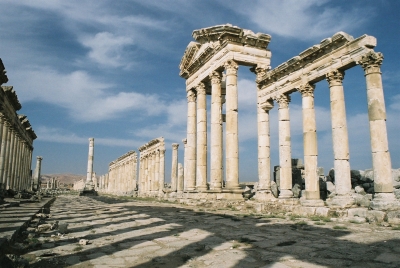
Damascus, the capital of Syria, is the oldest capital and one of the oldest continuously-inhabited cities in the world, with evidence of habitation dating back to around 10,000 to 8,000 BCE. In 2018, its metropolitan area was home to about 2.3 million people, and in 2008 UNESCO named the city the Arab Capital of Culture. The city has some 125 monuments from different periods of its history, including the 8th century Umayyad Mosque or Great Mosque of Damascus, one of the largest and oldest mosques in the world.
The city exhibits outstanding evidence of the civilizations which created it – Hellenistic, Roman, Byzantine and Islamic. In particular, the Umayyad caliphate created Damascus as its capital, setting the scene for the city’s ongoing development as a living Muslim, Arab city, upon which each succeeding dynasty has left and continues to leave its mark.
In spite of Islam’s prevailing influence, traces of earlier cultures particularly the Roman and Byzantine continue to be seen in the city. Thus the city today is based on a Roman plan and maintains the aspect and the orientation of the Greek city, in that all its streets are oriented north-south or east-west and is a key example of urban planning.
The earliest visible physical evidence dates to the Roman period – the extensive remains of the Temple of Jupiter, the remains of various gates and an impressive section of the Roman city walls. The city was the capital of the Umayyad Caliphate. However, apart from the incomparable Great Mosque, built on the site of a Roman temple and over-laying a Christian basilica, there is little visible dating from this important era of the city’s history. The present city walls, the Citadel, some mosques and tombs survive from the Middle Ages, but the greatest part of the built heritage of the city dates from after the Ottoman conquest of the early 16th century.
The line of the walls of the old city forms the boundary of the property. Although areas outside the walls that represent the expansion of the city from the 13th century, are considered related to the old city in terms of historical significance, and provide its setting and context, the key attributes of Outstanding Universal Value lie within the boundary. These include the plan of the city and its dense urban fabric, city walls and gates, as well as its 125 protected monuments including the Umayyad Mosque, madrasas, khans, the Citadel and private houses.
The attributes are vulnerable to erosion from a lack of traditional approaches to maintenance and conservation, and use of traditional materials, while its setting and context are threatened by lack of conservation policy for the historical zones outside the walled city and by regional planning projects.
Credit : UNESCO
Picture Credit : Google
Leave a Reply